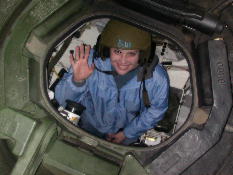February 12, 2007
The sunÂ’s brightness may change too little to account for the big swings in the climate. But more than 10 years have passed since Henrik Svensmark in Copenhagen first pointed out a much more powerful mechanism.
He saw from compilations of weather satellite data that cloudiness varies according to how many atomic particles are coming in from exploded stars. More cosmic rays, more clouds. The sunÂ’s magnetic field bats away many of the cosmic rays, and its intensification during the 20th century meant fewer cosmic rays, fewer clouds, and a warmer world. On the other hand the Little Ice Age was chilly because the lazy sun let in more cosmic rays, leaving the world cloudier and gloomier.
The only trouble with Svensmark’s idea — apart from its being politically incorrect — was that meteorologists denied that cosmic rays could be involved in cloud formation. After long delays in scraping together the funds for an experiment, Svensmark and his small team at the Danish National Space Center hit the jackpot in the summer of 2005.
In a box of air in the basement, they were able to show that electrons set free by cosmic rays coming through the ceiling stitched together droplets of sulphuric acid and water. These are the building blocks for cloud condensation. But journal after journal declined to publish their report; the discovery finally appeared in the Proceedings of the Royal Society late last year.
I won't claim to know the reasons why journals didn't publish this report, but could it perhaps maybe slightly be be that there's little room for dissent in climatology these days?
Remember that what you know about global warming is only what you've heard. That is, what has been chosen for you to hear. As Mark Steyn says, "Most of us aren't reading the science, or even a precis of the science. We're just reading a constant din from the press that 'the science is settled,' and therefore we no longer need to think about it: The thinking has been done for us."
This reminds me of a section in Bernad Goldberg's book Bias entitled "How Bill Clinton Cured Homelessness":
In 1999 [Philip Terzian, an editor at Providence Journal] wrote a column about a Village Voice study that showed that in 1988 the New York Times ran fifty stories on the homeless, including five on page one. But a decade later, in 1998, the Times ran only ten homeless stories, and none on page one. ... The conservative Media Research Center found that in 1990, when George Bush was president, there were seventy-one homeless stories on the ABC, CBS, NBC, and CNN evening newscasts. But in 1995, when Bill Clinton was in the White House, the number had gone down to just nine!
Homelessness didn't stop when Bill Clinton took office; it just stopped being front page news. But our worldview is shaped by what's showcased on the news, what the Important Issues of the day are, and it can be manipulated based on what journalists think you should hear about. The issues don't go away just because they're not reported.
Svensmark formed clouds from cosmic rays. Just because no one wants to publish it or put it on the nightly news doesn't mean it didn't happen. And it doesn't mean it doesn't have anything to do with global warming. It just means you haven't heard about it yet.
But now you have.
Posted by: Sarah at
06:15 AM
| Comments (1)
| Add Comment
Post contains 580 words, total size 4 kb.
Posted by: Will at February 15, 2007 02:04 PM (QRBGL)
49 queries taking 0.0611 seconds, 198 records returned.
Powered by Minx 1.1.6c-pink.














